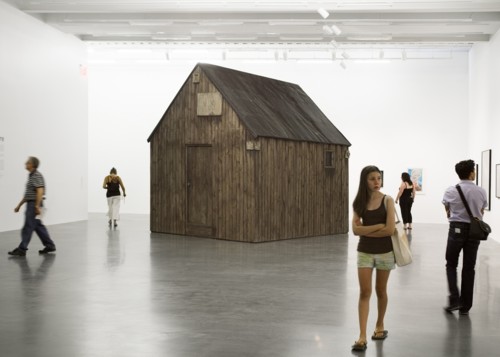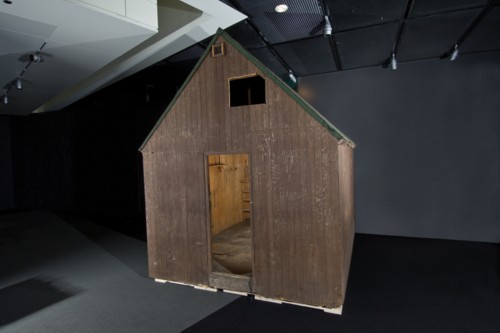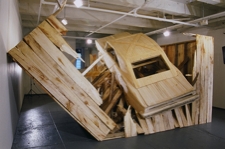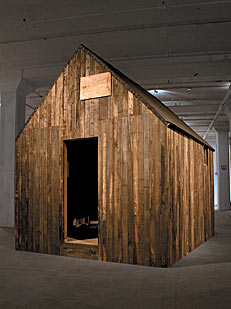Out There: August 2008 Archives
Robert Kusmirowski, Unacabine, 2008 Art forms that appeal to modern leftist intellectuals tend to focus on sordidness, defeat and despair, or else they take an orgiastic tone, throwing off rational control as if there were no hope of accomplishing anything through rational calculation and all that was left was to immerse oneself in the sensations of the moment. -- Theodore Kaczynski, Industrial Society and Its Future ("The Unabomber Manifesto")
A perfectly fine artist few in the
The poor gallery guard standing by the cabin had to keep repeating that no, the door didn't open. (Same problem with the Bucky Fuller 1930s Dymaxion car in the lobby space at the Whitney. That guard agreed in a charming way that it would be valuable to allow us to see the quirky vehicle's rotten or gutted or absent interior, and he would do what he could.) Everyone, of course, wants to open doors.
Wouldn't you know, at least a few of the younger folks didn't know who the Unabomber was -- or is, because Kaczynski's still alive, 66, in a Colorado prison for the rest of his days. He keeps up with current events, though, which we know because a few weeks back the cyber-must Smoking Gun wrote that Ted was perturbed that the actual cabin was on view as part of an exhibit in the Newseum, the ill-named temple of journalism that opened this year in

Unabomber cabin at the Newseum
According to Smoking Gun, the bomber saw his old residence advertised in a WashPost ad and was worried that the publicity surrounding the exhibit, as well as the shifted dwelling itself, would upset his surviving victims and the families of the three dead ones. (He also happens to be suing the government to prevent auction of his journals, letters, and ginormous manifesto manuscript.) The Newseum website invites online visitors to "Probe the Unabomber Cabin: Explore a mad hermit's life with videos and an interactive."
"An interactive." Where's the display devoted to the planet's last remaining copy editor?
Unabomber hideout, real and simulacrum. Newseum and
We now arrive at the place where the art critic weighs in, elaborating upon the differences between the two cabins and the way their differing viewers perceive and react to them. What if the museums swapped cabins? Next, there's the obligatory art historian (not quite a critic), grounding the problem with a discussion of mimesis and reproduction in a variety of cultures and the appeal and even magic implicit in verisimilitude and theatrical imitation.
Were I the initial critic, I'd find some way of dragging my reader into the Brooklyn Museum's tableaus of American Colonial and art deco décor, dim and romantic rooms that hypnotized baby Jeff and made him wish he could escape his mother's noise and vanish into a calm, upholstered past.
What a present-day real critic should mention, if he or she had the sense, is that in the last few years at least two other Unabomber cabins sat firmly on

Chris Larson's Pause, 2005

Unabomber's Cabin, Montana, Seth Weiner, 2007
In a truly contemporary, interactive institution, one should be able to choose the soundtrack of one's experience. So Out There must therefore ask, what exactly would you, kind reader, wish to hear spoken from beneath the Unabomber's various floorboards?
* * *
For an automatic alert when there is a new Out There post, email
